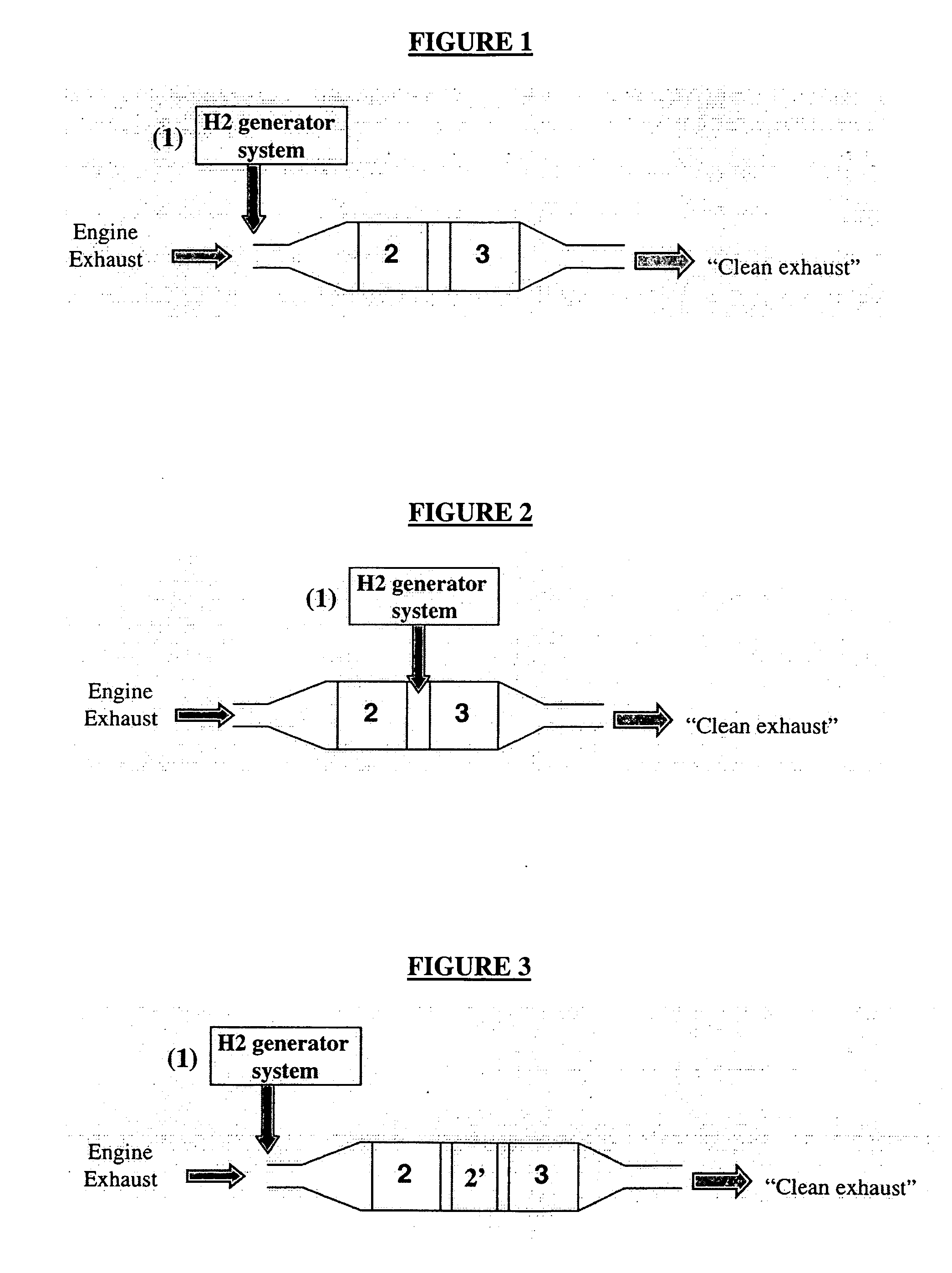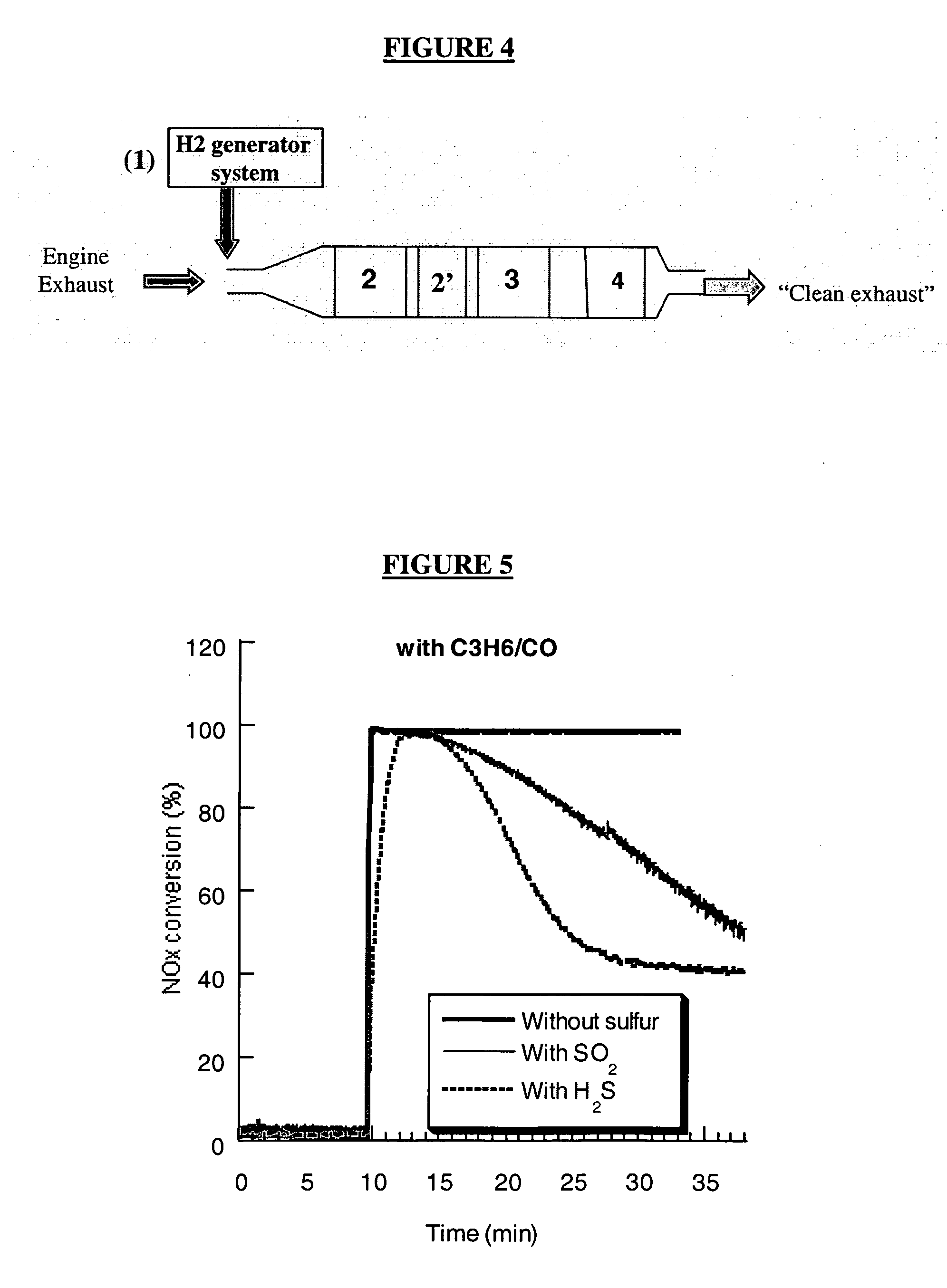Sulfur oxide/nitrogen oxide trap system and method for the protection of nitrogen oxide storage reduction catalyst from sulfur poisoning
a nitrogen oxide and nitrogen oxide technology, applied in the field of sulfur oxide/nitrogen oxide trap system and protection of nitrogen oxide storage reduction catalyst from sulfur poisoning, can solve the problems of limited sulfur storage capacity, shorten the life of nsr catalyst traps, and significant fuel penalties, so as to improve the control of hydrogen sulfide, hydrocarbons, and nh3 emissions. , the effect of improving the nox adsorption efficiency
- Summary
- Abstract
- Description
- Claims
- Application Information
AI Technical Summary
Benefits of technology
Problems solved by technology
Method used
Image
Examples
example 1
Effect of SO2 and H2S on NOx Reduction Efficiency at 450° C.
[0090] The interaction of sulfur species with noble metal sites (e.g., Pt and or Rh) can directly be determined by looking to NOx reduction under rich conditions. Any poisoning of noble metal sites will translate into a decrease in NOx conversion. FIG. 5 depicts a graphical illustration of the effect of trapped SO2 and H2S on NOx reduction at 450° C. under a simulating rich exhaust containing C3H6 / CO (Feed 2a). As can be seen in FIG. 5, 100% NOx conversion is achieved without sulfur. Upon addition of sulfur species (SO2 or H2S), NOx conversion decreases as a function of exposure time. For instance, after 15 minutes of exposure to SO2, NOx conversion decreases by about 20%. This decrease reached 50% in the presence of H2S, indicating that sulfur poisoning of noble metal sites is more severe with H2S than with SO2. NOx conversion stabilizes at around 40%, which indicates only a partial poisoning of the noble metal sites. FIG...
example 2
NOx (NO+NOx) Adsorption Under Lean Conditions (Feed 3) at 300° C. after Oxidation of Adsorbed Sulfur Species
[0093] In order to exhibit the extent that NOx storage sites (e.g., Ba) are poisoned by the trapped sulfur species, we have evaluated NOx storage efficiency at 300° C. under lean conditions (Table 1, Feed 4) for a fresh NSR trap and after different cycles of sulfur-poisoning. Each cycle of poisoning consists of treating Pt-containing NOx trap at 300 or 450° C. with a rich gas feed containing SO2 or H2S (Table 1, Feed 2a or 2b) for 30 minutes followed by oxidation under lean conditions (Table 1, Feed 3) for 15 minutes. Any poisoning of NOx storage sites (e.g., Ba) by sulfur translates into a decrease in NOx storage efficiency. The NOx storage was evaluated using Feed 4 (Table 1).
[0094]FIG. 9 depicts a graphical illustration of NOx storage efficiency (Feed 3) at 300° C. following 1 cycle poisoning by SO2 under simulated rich conditions containing C3H6 / CO (Feed 2a) and oxidatio...
example 3
Understanding Sulfur Interaction with NOx Storage Sites (e.g., Ba) and NOx Reduction Sites (e.g. Pt)
[0096] To understand the interaction of sulfur species with barium sites, it is important to determine at what conditions (rich / lean) barium sites are poisoned by sulfur. Under rich conditions, barium sites exist mainly as barium carbonate as indicated by XRD (FIG. 14). Thermodynamic calculation (FIG. 15) shows that 90 ppm of SO2 or H2S species can pass through barium carbonate at 450° C. without forming BaSO3 or BaS. Hence, it can be concluded that under rich gas mixtures and a temperature of 450° C., no adsorption of sulfur species on barium sites occurs. It is important to understand why barium carbonate sites are poisoned by the trapped sulfur species under lean conditions. There is a correlation between the sulfur poisoning of noble metal sites under rich conditions and barium sites under lean conditions. Indeed, any decrease in NOx reduction efficiency in the presence of sulfur...
PUM
 Login to View More
Login to View More Abstract
Description
Claims
Application Information
 Login to View More
Login to View More - R&D
- Intellectual Property
- Life Sciences
- Materials
- Tech Scout
- Unparalleled Data Quality
- Higher Quality Content
- 60% Fewer Hallucinations
Browse by: Latest US Patents, China's latest patents, Technical Efficacy Thesaurus, Application Domain, Technology Topic, Popular Technical Reports.
© 2025 PatSnap. All rights reserved.Legal|Privacy policy|Modern Slavery Act Transparency Statement|Sitemap|About US| Contact US: help@patsnap.com



